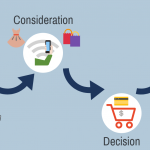6 Marketing Automation Mistakes Ecommerce Businesses Must Avoid
The e-commerce industry has taken a big leap in the last several years, thanks to marketing automation. Tools like email marketing automation software make e-commerce tasks run more easily and effectively at a much cheaper cost in the long term. It improves the customer experience and relieves the marketing team of mundane, repetitive tasks. Most importantly, it boosts sales and profit. Statistics show that marketing automation drives a 14.5% increase in sales productivity and a 12.2% reduction in marketing overhead.
However, some marketers fail to take full advantage of the benefits that a marketing automation software has to offer and make mistakes that greatly affect their ROI and growth.
Here are the things you should avoid as you set-up your automated email marketing campaigns:
1. Creating a non-personal email marketing campaign
Treating all your customers the same means you’re only meeting the needs and preferences of few. This mistake is no longer excusable because there’s a broad range of personalization strategies that can be implemented through your marketing automation software. To avoid this, segment your customers and target specific clients with email campaigns that are relevant to their particular needs. This way, you’re offering them a targeted solution to their pain-point and this will ultimately help you boost conversion.
2. Assuming that a customer journey is linear
When marketing an e-commerce store, you’re probably fully aware of the stages of the customer journey – and if not, here’s a quick reminder:
- Awareness
- Consideration
- Decision
However, this journey is not always linear. Each client responds differently to your campaign so each should be treated accordingly, so don’t send all contacts the same marketing messages all the time, use this opportunity to create more dynamic customer journeys.
Some customers can move back to the previous stage of the customer journey. They may have shown interest in buying a specific product, but that doesn’t mean that they wouldn’t go back to the consideration stage where they weigh their options. Understand your customers deeper by analyzing their behavior on your website and their email engagement (Open, click through and conversion rates).
3. Putting all your eggs in one basket
Marketing automation extends beyond email. A holistic marketing automation strategy considers other channels such as social media, affiliates, content marketing, and paid ads. All these should be integrated to support each other.
For instance, you can invite your social media followers to subscribe to your newsletters so that they can receive exclusive deals and offers. You can also set up automated email campaigns targeted to customers showing specific behaviors like frequenting a particular product page. Aside from that, you can tailor the email content to what users respond best to on social media, and vice versa.
4. Focusing on conversion rather than retention
According to a survey, increasing customer retention rate by a mere 5% might grow the business revenue by 75%. Unfortunately, it’s very common for online shop owners to focus more on the initial conversion and the new customers than retaining existing customers.
The goal is to sell, but your job shouldn’t end after the customer hit’s that ‘Shop’ button. In fact, it should be the beginning of a long-lasting relationship. Take your customer relationship to a new level after the first sale. Remember, a customer who has purchased from you in the past has a 60% chance of making at least one more purchase.
Having a loyalty program for existing customers can help strengthen your connection with them. You can also show them that their voice matters by asking for their feedback on your product and service so that you can further improve it. Reward them with exclusive discounts and special offers intended for existing customers only. Once trust and loyalty have been built, your relationship with existing customers can be more profitable. Acquiring new customers is great, but don’t forget your existing ones while you’re at it.
5. Everyone is on their phone anyway
The convenience of mobile devices makes it the most popular choice for users. Make sure you’re catching up with this trend by making your emails, websites, and social media content mobile responsive. To make your content mobile-friendly, it has to load fast and the text and images should be readable for small screens. Use a marketing automation platform that will show you how each campaign appears on any type of screen.
6. Not analyzing your campaign data
Automating tasks is indeed enjoyable, but some e-commerce marketers and shop owners tend to rely on this too much. They set up the campaign, automate it and repeat. Without really learning from each campaign, there is never a way to optimize your activity and your brand might be left behind. User behavior changes rapidly. Just because they respond well to a particular campaign, doesn’t mean it will happen over and over again. Or even when it does, you shouldn’t let your sales stagnate. Always keep up with the numbers and aim for improvement and growth.
Your email marketing automation software most likely has a data analytics tool to help you analyze your campaigns. Checking your data from time to time enables you to spot your weak points and opportunities to improve your strategies.
In conclusion, making mistakes is fine, it’s a part of life and it’s a part of every business. But using the right marketing automation software will help you learn from every error and find the tools to continue on a new path, and most importantly, to get better conversion rates from your online e-commerce shop.
Good luck!






